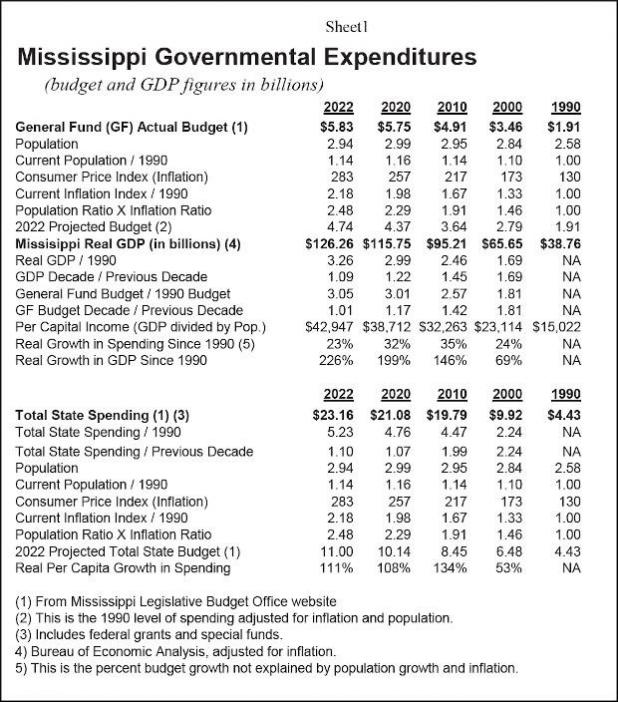
Wyatt's World
One very geeky thing I do is keep track of the Mississippi state budget from an historical perspective. I do this simply because I can find no other source for this important information.
Over the years, I have been perfecting the spreadsheet you see on the right. It looks at the state budget, state GDP, inflation and population and tries to make sense of how government is growing in relation to our state economy.
There are two main aspects of the state budget: the general fund and the total budget. The general fund is the part of state government funded directly by the state of Mississippi through state taxes. It’s only about a fifth the size of the total budget.
The total budget includes federal grants and special purpose funds, such as the state gasoline tax. This budget is $23 billion a year, constituting about 18 percent of our state GDP.
These numbers don’t include city and county budgets, nor federal spending that is independent of the state. Including that, total local, state and federal spending would amount to about 30 percent of our total economy, which is the national average.
One thing should be clear from looking at the numbers: They are all greatly increasing over time, except for population.
The state general fund budget is about three times bigger than it was in 1990 but that’s half the growth rate of the total budget which is nearly six times bigger than 1990. This difference is caused by greater federal spending than state spending.
One thing my spreadsheet does is adjust this growth for population changes and inflation. If you do this, the state general fund budget is only 23 percent more than it was in 1990 and the total state budget is 111 percent more than 1990. That’s an important added perspective.
The spreadsheet also looks at state budget growth by decade. This past decade has seen decreased state general fund growth compared to the previous two decades.
My source for the budget data is the state legislative budget office website, which anyone can access. Their “publications” menu item has all the budget reports. I use the one with the latest date.
I used the U. S. Bureau for Economic Analysis for the federal and state GDP and inflation data. I use the Census Bureau for population.
I have left out the 2023 budget data because it’s preliminary, but there are some whopping increases based on an influx of new federal money.
When I first started doing this, the numbers made me conclude that state spending was increasing beyond what was justifiable based on population growth and inflation. In this context, this is true. However, I have Northsider Whit McKinley to thank for expanding my perspective. He noted that I also needed to look at state GDP growth to get the bigger picture.
Indeed, since 1990, real state GDP growth is double the growth in the total state budget. That means that even though the state budget is increasing rapidly, the private sector is growing at twice the rate of government, 226 percent versus 111 percent compared to 1990. From this perspective, state government is not keeping up with the private sector.
As the overall state economy grows, you could argue that the state government should grow with it. As the private sector affords us faster computers, bigger houses and nicer cars then the public sector should, arguably, afford us better schools, better criminal justice systems and better public facilities.
Of course, there is no need to grow government just to grow government. The private sector will always be the preferred method of driving the economy and meeting our individual economic needs. If our public sector services are efficient and effective, there is no need to grow faster than the combination of population and inflation.
But that is not currently the case. Our teachers need to be paid the average of the surrounding states. They are not. Our prisons need to be run effectively with comprehensive rehabilitation services. Instead, they’re run by gangs. Facilities at our state parks have deteriorated tremendously over the last 15 years. There are many public state needs that need to be addressed.
Simply cutting state government and washing your hands of the painstaking task of public service is not enough to gain my respect. Sure, we all want to cut government waste and there’s plenty of it. Has
been and always will be. The public sector, by its very nature, will never be as efficient as the private sector.
But true state leadership is knowing when to cut and when to grow. It’s not black and white. Like all of life, it’s complex with infinite shades of gray. We need a government as vibrant and as robust as our private sector.
Since 1990 the private sector has grown at twice the rate as our total state budget. Perhaps that’s why we complain so much about bad state services.
Wyatt Emmerich is publisher of The Northside Sun in Jackson and owner of Emmerich Newspapers.

